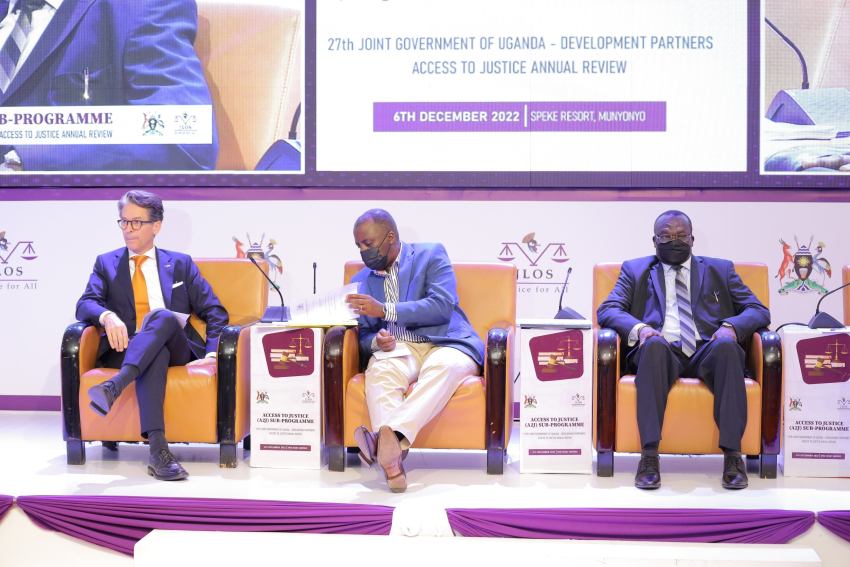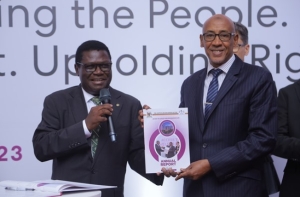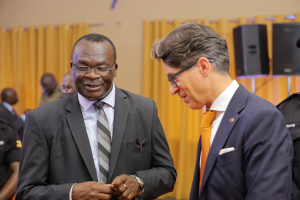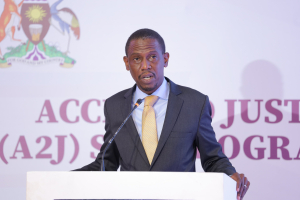Assessment of JLOS Performance (FY 2021/22) by Development Partners
##
Assessment of JLOS Performance delivered by Mr. Nicolas Gonze on behalf of the JLOS Development Partners Group (DPG).
- My Lord, it is again, the time of the year for us jointly to take stock of the performance of the Access to Justice Sub-programme.
- It is my honour to deliver these assessments on behalf of the Access to Justice Development Partners Group. I would like to thank deeply and sincerely members of the group for the valuable contributions to the assessment, and their continued interest and dedication to the sub-programme.
- My Lord, the methodology of our assessment has remained the same as in the past. Before providing a highlight of our detailed comments and assessments, I would like to provide some general comments.
General Comments
- During the technical review on 25 November 2022, we had an in-depth and constructive discussions, and provided several recommendations on actions to improve the reporting.
- Overall, we note that there is a marked improvement in the quality of reporting compared to previous years. For this, we would like to acknowledge and greatly appreciate the valuable contributions of individuals and institutions who invested time and energy in the drafting of the report.
- I would also like to extend our appreciation to the Governance and Security Programme Secretariat for coordinating the drafting of the report, and for facilitating our cordial collaboration with Government.
I now turn to the highlights of our assessment of the performance during the period under review.
My Lord, under Outcome 1 on “People centred service delivery system strengthened”.
- We note that public trust in Access to Justice institutions is 9% above the target of 60%, which is commendable.
- We observe the launch of construction of the JLOS House, which when completed, when completed will be emblematic of the sub-programme’s endeavours to create peaceful and well-functioning society. So congratulations for the launch of the construction of the JLOS House.
- My Lord, although Judiciary is not part of this sub-programme, we would like to take this opportunity to recognise their efforts to improve the quality of state brief schemes to ensure that a person who cannot afford a private lawyer are represented effectively.
- We note that institutions have built capacity on management of GBV cases, but a witness protection law would be crucial for more progress.
- We positively note the UPF’s responses to the high prevalence of domestic violence including 7,000 SGBV investigations and training of trainers for handling of GBV cases and collecting evidence from crime scenes.
- The amendments to the Succession Act were eventually passed.
- My Lord, with conviction rates now over 70%, the Sub-programme is making significant progress. We recall a time when it was just slightly above 50%.
- We observe that community service is important and shows good results. In the reporting period, the Ministry of Internal Affairs supervised almost 17,000 community service orders, which is a significant contribution to case backlog reduction, the community and rehabilitation of offenders.
- However, as underlined by Ambassador Sadek in his speech, the DGF which has been supporting legal aid to more than 90,000 Ugandans is closing. It is not clear how the sub-programme will address this significant gap.
- It is worrisome that prison congestion levels increased from 323% to 351%. There is a need for a solid analysis of the main reasons for the congestion and why the remand population keeps growing.
- We observe with concerns that the proportion of magisterial areas accessing state funded legal aid is below 50%.
Overall, the assessment of Development Partners of Outcome 1 is “Satisfactory”.
My Lord, regarding Outcome 2 “JLOS Business Processes Reformed and Strengthened”
- We note that the targets for all (5) indicators were reported as met. These included case disposal rate of 55%, percentage of districts with one-stop front line service points at 83% and a conviction rate of 82% in corruption cases.
- We note with interest the conduct of normal sessions in the High Court during which 1,964 cases were concluded. We heard that regular hearing of criminal cases was being piloted at the high court leading to significant reduction in backlog. This is an issue we previously advocated for and would be pleased to hear more about.
- Other commendable achievements reported include:
- DPP consistently surpassing its quarterly targets of prosecutorial decisions;
- The country wide roll-out of small claims procedure, with a high number of and disputes resolved at the pre-trial stage;
- Broadly, a sizable number of cases were resolved through mediation with a success of 57%.
- Increased percentage of convicted prisoners from 46.5% to 49% during the period under review;
- My Lord, 206,000 cases, which accounted for 55% of the total caseload were disposed during the period under review. With the highest disposal rate of 71%, we would like to commend the efforts of lower courts in dispensing justice.
- In addition, we note further achievements including:
- The full adherence by UPS to production warrants;
- 171 cases won by the AG which saved GoU shs 424billion;
- DPP’s sanctioning of 56% of land cases and prosecution of 75% of cases against a target of 70%
- Furthermore, the target for level of automation of case management systems was exceeded and the target of JLOS Institutions with a functional M&E System was also achieved.
- However, we are concerned about the 11 months average length of stay on remand. We are also concerned that female suspects spend about 4 months more time on remand than male suspects.
- Also concerning is the worsening of average time taken to dispose cases from approximately 870 days in the previous reporting period to 930 days during the period under review.
- In addition, we note that budget cuts adversely affected operations of the DPP and late releases in quarter 1 further jeopardized their performance. UPF faced a similar funding challenge.
- My Lord, it is also worrying that the monthly average prison population now stands at 70,000 inmates, an increase of 0.7% from the previous reporting period.
- Finally, we analysed the case disposal and clearance rates at the Supreme Court and Court of Appeal and would like to respectfully urge for an internal reflection on how best to improve on the case disposal and clearance rates at these courts.
In view of the detailed comments above, the assessment of the performance under Outcome 2 is “Satisfactory”.
My Lord, regarding Outcome 3 on “Compliance with the Uganda Bill of Rights Strengthened”
- We note the launch of the National Action Plan on Business and Human Rights in October 2021 which is a significant achievement.
- In addition, we note the inspection of about 590 detention facilities across 9 regional offices by Uganda Human Rights Commission. In future, inclusion of the methodology of these inspections and how involved other mandated actors notably Justices of Peace are in inspecting places of detention would enrich the reporting.
- We note the outstanding performance of the Anti-Corruption Court Division (ACD) with a case clearance rate of 103%, a disposal rate of 51% - up from 48.5% registered in the previous reporting period, and, a conviction rate of 88%.
- My Lord, we note an interesting practice at the ACD, which limits the number of mentions and adjournments to only 3, after which active prosecution must start to avoid dismissal of a case. The practice can be instrumental in addressing case backlog, lengthy trial processes, unnecessary arrests or initiation of prosecution before investigations are complete.
- We note that except the indicator on increased capacity of policy makers and planners on HRBA, (5) out of the (6) performance indicators were not met. The indicators not achieved were: Proportion of human rights recommendations implemented, disposal rate of Human Rights cases, DPP’s conviction rate of corruption cases, and, proportion of citizens aware of the provisions of the bill of rights.
- Our view is that the finalisation of the National Action Plan on Human Rights has stagnated over the last couple of years.
- Also of concern, the inspection by UHRC revealed inadequate staffing at most police facilities coupled with a limited number of female police officers deployed at various police stations, and in particular in refugee hosting districts.
- We note with regret the reporting of continued detention of suspects beyond the 48 hours as stipulated in the Constitution. This is an issue we have consistently raised for several years and even before the COVID-19 pandemic and we encourage the government to take concrete action to address it.
- Regrettably, case clearance by UHRC was only 20% against a target of 76% and the proportion of decisions against JLOS institutions to total cases concluded by UHRC is unlikely to have been achieved.
- As highlighted by Ambassador Sadek in his intervention, torture and denial of personal liberty remain the most reported human rights violation over the years and the report states that the two topmost implicated institutions are UPF and UPDF.
- Another concern is the fact that the majority of 80% of trainees were men. The explanation provided in the report for this was neither clear nor convincing. There should be concerted effort to increase participation of women in trainings.
- Finally, we note lack of progress in the development of a law to provide for recovery of the proceeds of crime.
In light of these comments, the overall assessment of Development Partners of Outcome 3 was that limited progress was achieved.
- Therefore, in summary, 2 out of the 3 Outcomes were assessed as “Satisfactory” and 1 assessed as “Limited” progress.
- My Lord, these were the observations and assessment of the members of the Access to Justice Development Partners Group.
Thank you for your kind attention.
##
NEWSROOM
Latest News
Privacy Policy
News Archives






